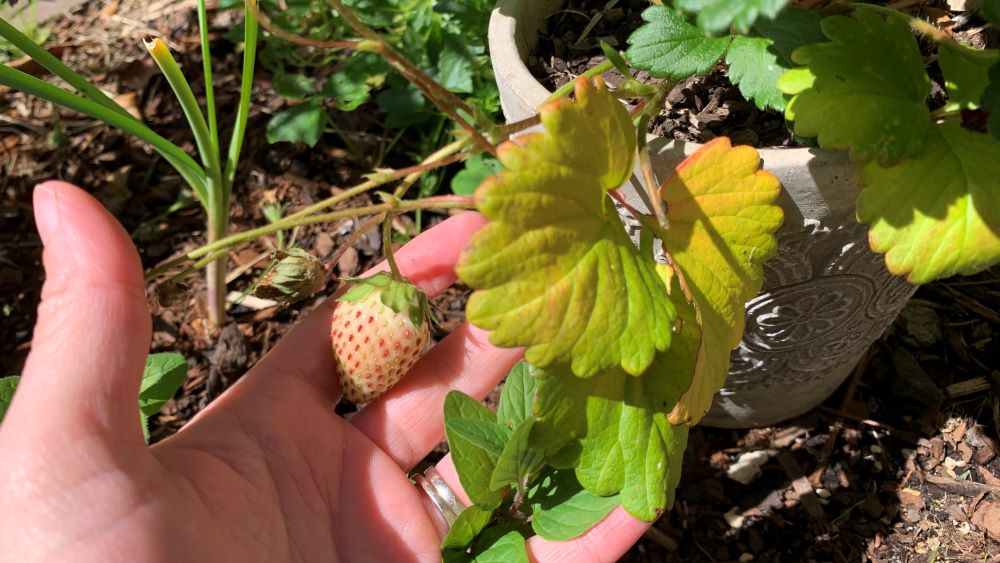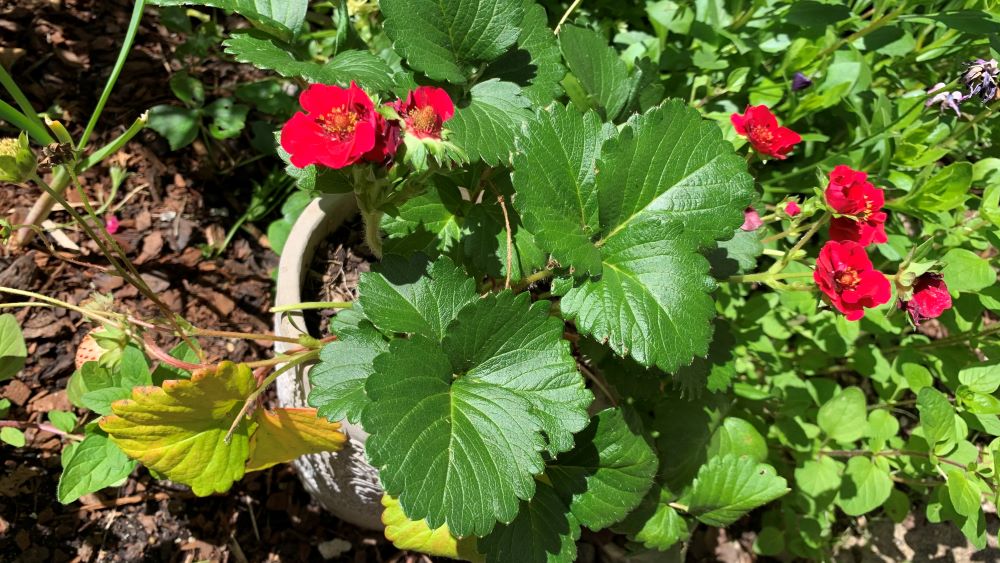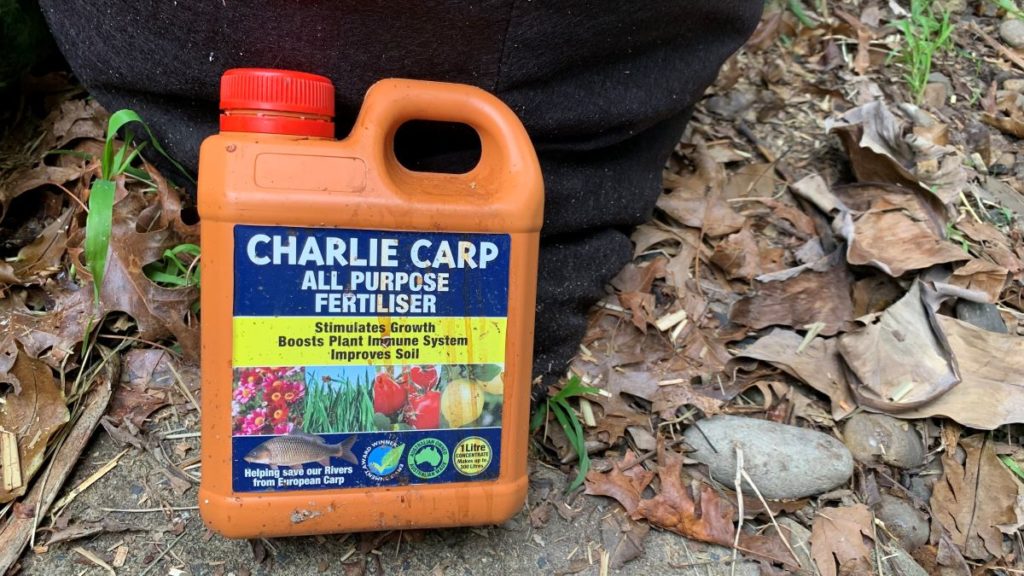Yellow leaves on strawberry plants can be caused by nitrogen deficiency, overwatering or pest attack. To help the strawberry plants recover prune off the yellow leaves, give it a feed of liquid nitrogen fertilizer, add pelleted chicken manure and move it to a sunny position. Check for aphids or scale and treat them with Neem oil.
Yellow leaves on strawberry plants can be easily fixed once you figure out the cause. This article will explore the top causes of yellow leaves on strawberry plants and what to do to fix it.

Top causes of leaves turning yellow on strawberry plants
Here are the top reasons why leaves turn yellow on strawberry plants. Check out each one and see if this might be the cause of the problem for your strawberry.
1. Nitrogen deficiency
Strawberry plants that lack nitrogen can develop yellow leaves. If you notice that young leaves have turned yellow, it is likely that nitrogen deficiency is the cause.
For a strawberries planted out in a garden bed, give them a dose of diluted liquid nitrogen fertilizer every 2 weeks over Spring. Add a few handfuls of pelleted chicken manure around the plant for longer lasting nitrogen. You should see the leaf color improve within a few weeks.
When planting out a new strawberry plant, prepare the soil with compost and aged cow manure.

2. Old leaves
Old strawberry leaves will turn yellow once they have finished growing. This is the natural process of leaf replacement. Simply pinch these leaves off at the base of the plant. They will be more susceptible to pest attack so it is best to remove them.
Snip the leaves off with secateurs if the stems are too difficult to pinch off. This will keep the plant neat and give it more room to grow new leaves.

3. Overwatering
Overwatering can cause strawberry leaves to turn yellow. Excess water will wash away nutrients particularly nitrogen from the roots. Nitrogen is easily washed out of the soil and is essential for the green leaf color. Nitrogen is connected to the development of chlorophyll in the leaves which help to support photosynthesis.
Strawberry plants like regular water but too much can be a bad thing. Check the soil before watering to see if it is dry 1-2 inches down.
Mulch the plant with bark mulch or straw which will help to regulate the water that reaches the roots. Bark mulch will absorb extra water and slowly release it over time. Slow down your watering schedule and allow time in-between watering for the soil to dry out slightly.
Overwatering is more likely to happen to potted strawberry plants. Make sure they are not sitting in a tray of water as their roots can become too wet and rot. This will stop them from absorbing the nutrients they need and the leaves can turn yellow.

4. Aphids or scale
Pest attack can be the cause of yellow or damaged leaves on strawberry plants. Sap sucking insects such as scale or aphids can damage the plant, reducing the amount of water and nutrients available. This can turn the leaves yellow.
You can usually notice spots on the leaves which turn yellow and brown. Look out for tiny green aphids or brown scale that hide near the leaf stems.
Scale
Scale bugs are small beetle shaped insects which will suck the sap from your strawberry plant. Scale can be treated with eco oil and should be dealt with as the sap they produce can attract ants. I like to spray the bugs with a strong jet of water from my hose to see if I can remove them before treating with oil.
Aphids
Small green aphids can attack strawberry plants sucking their sap and causing leaves to turn yellow. These insects will attack new growth and can appear quickly in spring and fall.
Ladybugs will move in to eat the aphids but you may need use horticultural Neem oil to address the problem. Aphids can cause damage to young strawberry plants so deal with them quickly.
5. Spider Mites
Spider mites can wreak havoc on strawberry plants, causing leaves to turn yellow. These tiny arachnids pierce leaf cells with their needle-like mouthparts, sucking out the chlorophyll. This disrupts photosynthesis taking away the green pigment in the leaves causing them to turn yellow.
You can often see tiny white or yellow dots where spider mites have punctured leaf surfaces. If left unchecked, the mites can reproduce fast causing the plant to drop its leaves, slow its growth and reduce strawberry prroduction.
I have found that spraying the leaves with a sharp jet of water can work to quickly remove these pests. You can follow this up with spraying the plants with Neem oil or a horticultural soap.
6. Lack of water
Underwatering can cause your strawberry leaves to turn yellow. Strawberry plants growing in sandy soil can dry out quickly. Very hot weather can dry strawberries grown in full sun quickly causing the leaves to turn yellow and then brown.
Regularly water your strawberry plants, particularly in the warmer months. Check the soil over winter too if you have low rainfall to make sure that the roots and soil are moist.
Consistent water will help to prevent yellowing leaves on strawberry plants over spring and summer.
7. Compacted soil
Strawberry plants growing in compacted soil can develop yellow leaves. Plant roots can struggle to absorb the nutrients they need and may suffer from root rot. The leaves will turn yellow if the plant cannot absorb key nutrients such as nitrogen, magnesium and iron.
To avoid this make sure you plant your strawberry plants in well-drained soil that has been improved with organic matter. Dig through aged compost or aged cow manure before planting your strawberries out into garden beds.
If you are planting your strawberries into pots, use good quality potting soil that drains well and contains a slow release fertilizer.
8. Fungal diseases
Fungal diseases can lead to yellowing of strawberry leaves. Common fungi like “Leaf Spot” and “Powdery Mildew,” can stop the plant from absorbing nutrients and photosynthesising and reducing the chlorophyll production in the leaves.
The two most common fungal disease to affect strawberries are below:
- Leaf Spot (Mycosphaerella fragariae): Look out for circular or irregular dark spots with defined edges appear on the leaves. As the disease progresses, the spots might get bigger and the centers could become grayish-white.
- Powdery Mildew (Podosphaera spp.): A white powdery substance covers the upper surface of the leaves. This can lead to curling, distortion, and yellowing of the leaves.
To prevent fungal diseases in strawberry plants make sure they are spaced apart at least 12 to 18 inches (30 to 45 cm) to allow for good air flow. Plant them in a space that gets full sun and avoid watering directly on the leaves.
You can treat your strawberry plants with fungicide if the problem continues but I prefer to trim off the damaged leaves instead. Put the infected leaves in the garbage rather than your compost to avoid it spreading to other plants.
You can also remove the infected plant to avoid it spreading to to the rest of your strawberry patch.
9. Iron deficiency
Iron deficiency can cause strawberry leaves to turn yellow. Iron plays a vital role in chlorophyll production, which is the green pigment in plant leaves. If a strawberry plant does not have enough iron it will reduce the plants ability to photosynthesize. Iron deficiency often impacts the younger leaves at the tips of the branches first.
Strawberry plants that are iron deficient will develop yellowing between the leaf veins. The veins themselves will turn bright green. To fix this give your strawberry plant a dose of iron chelate. You can spray it directly onto the leaves to fix the problem quickly.
Slightly acidic soil conditions will also help your strawberry plant to absorb iron from the soil. Strawberries generally prefer a slightly acidic soil pH in the range of 5.5 to 6.5 so test your soil first. Adding extra organic matter will make the soil slightly more acidic over time or you can correct it fast by adding elemental sulfur in small amounts. This will be available from your local garden center.
10. Magnesium deficiency
Magnesium deficiency can cause yellow leaves in strawberry plants as it plays a vital role in chlorophyll formation. Without enough magnesium the leaves can’t produce chlorophyll causing older leaves to turn yellow, particularly between the veins. This will appear differently to iron deficiency which usually causes older leaves to turn yellow first.
To fix this problem add magnesium-rich fertilizers like Epsom salt (magnesium sulfate) to the soil. Applying foliar sprays containing magnesium can also fix the problem fast.
What to do when strawberry leaves turn yellow
Here are the 3 easy steps to follow if your strawberry leaves turn yellow.

1. Check the soil and water it well
Stick your finger 1-2 inches below the surface of the soil to check the moisture level. If the soil is dry, water it deeply and allow it to dry out slightly between watering. If the soil is too wet, add mulch and allow at least 2-3 days for the strawberry to dry out before watering again.
2. Liquid feed with nitrogen fertilizer
Add dilute liquid fertilizer to the strawberry plant to give it a nitrogen boost. Give it a feed of pelleted chicken manure and water it in well.

3. Trim off yellow and brown leaves
Once you have taken these steps trim off old and damaged leaves with sharp secateurs. This will tidy up the strawberry plant and make room for new, green leaves. If the leaves have signs of fungal disease like black spots or gray marks, throw them in the garbage.
Yellow leaves on strawberry plants | Summary
Yellow leaves on strawberry plant can be trimmed off once the cause is identified and solved. Treat any pests and dispose of any leaves that have been infected with mold or fungus. Use sharp secateurs to remove the yellow and dying leaves and stems. Strawberry plants are hardy and will recover once they are given the nutrients and water they need.
Strawberry plants can struggle whey they are transplanted from a pot to the ground. Over winter, the strawberry plant will slow its growth and the outer leaves can turn yellow and then brown. The plant will recover when the weather warms in spring and will grow new, green leaves.
Happy gardening.
I am an accredited practicing dietitian, experienced gardener and a dedicated cook. I love writing and sharing my experience so you can learn from my successes and mistakes.
